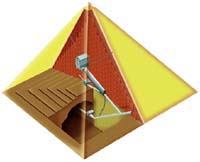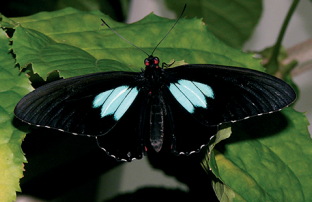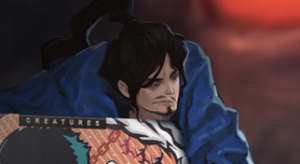급속한 과학발전에도 불구하고 우주는 아직도 많은 비밀을 간직하고 있는 미지의 세계이자, 인류의 미래와 함께 할 개척지다. 이에 과학자들을 비롯한 많은 분야의 사람들이 이 두 개척지에 끊임없는 관심과 열정을 쏟아붓고 있다. 이번에 소개하는 곳은 "Sea and Sky"(http://www.magicnet.net/~jdk/seasky.html)라는 이름을 가진 매우 유명한 사이트다. 여기에는 바다와 우주에 대한 많은 그림과 자료, 관련정보 등을 가지고 있으며, 특히 바다와 우주에 관련된 다양한 게임도 제공된다. 다음의 자료는 "Explore the sea"의 "Reef Life"(http://www.magicnet.net/~jdk/sea2.html)에서 발췌한 내용이다.
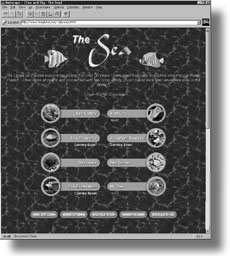
해면동물
겉으로 보기에는 식물같지만 사실 해면동물은 바다에 사는 가장 원시적인 동물 중 하나다. 해면은 포리페라 그룹에 속한다. 대부분의 사람들은 전세계 부엌과 욕실에 자리를 차지하고 있는 무색의 건조 해면(스펀지)에 대해 알고 있을 것이다. 하지만 큰 바다에서 살고 있는 해면들은 각양각색의 색과 모양을 가지고 있다. 이들 대부분은 비교적 크기가 작지만, 몇몇 종들은 지름 6피트 이상 자라기도 한다.
해면은 실제 조직이나 기관이 없다는 점에서 다른 해양 무척추동물과 구분된다. 해면조직은 세포의 단순한 집합체로 구성돼 있다. ‘포리페라’라는 명칭은 ‘구멍을 만들다’라는 뜻이다. 해면의 조직은 소실(小室)과 연결관으로 이루어진 거대한 망상조직을 에워싸고 있으며, 소실과 연결관은 표면으로 나와 있는 열린 구멍에 연결돼 있다. 해면은 구멍을 통해서 물을 끌어들여 영양물을 걸러낸 후, 열림 구멍으로 물을 다시 뿜어내는 과정을 통해 영양을 섭취한다. 모래톱에 많이 있는 해면들은 모양과 색에 있어서는 산호와 닮았지만, 자세히 관찰해 보면 큰 차이가 있음을 알 수 있다.
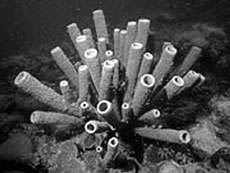
산호와 말미잘
많은 사람들이 산호와 말미잘을 식물로 여기지만, 사실 이것들은 동물이다. 이것들은 유자포동물로 알려진 원시적인 단일 동물군(群)의 한 부류에 해당한다. 해파리도 여기에 속한다. 이 동물들은 대칭형 몸체와 가시를 가진 촉수, 가운데 위치한 입 등을 특징으로 가지고 있다.
산호의 실제 구조는 수백, 수천개의 미시동물이 집단을 이뤄 성장하는 형태다. 이렇게 작은 산호 폴립이 모래톱을 구성한다. 이들의 작은 칼슘 껍데기들이 수천년간 축적되면 세계에서 가장 큰, 살아있는 구조물이 형성된다. 대부분의 유자포동물은 집단적으로 밀집해 살아가지만, 몇몇은 해파리처럼 자유 유영을 한다. 이런 동물들은 먹이를 잡아먹기 위해 ‘네마토시스트’라 불리는 가시세포를 이용한다.
해파리를 비롯한 몇몇은 사람에게 큰 고통을 줄 수 있다. 말미잘은 광대고기와 공생관계를 유지하는 것으로 잘 알려져 있다. 이것은 양쪽 동물 모두에게 유익한, 특별한 생존전략이다. 말미잘은 광대고기의 보호를 담당하고, 광대고기는 말미잘의 먹이를 제공한다.
해양 포유동물
몇 백만년전 최초의 동물들이 바다에서 육지로 이주했다. 그러나 이중 몇몇 포유동물들은 지구 전체에 걸쳐 일어난 기상과 지형변화 때문에 바다로 되돌아 갔고, 이후 바다 환경에 완전히 적응한 형태로 진화됐다. 대부분의 돌고래와 고래가 여기에 해당하는데, 이들은 고래류(cetacea)라고 알려진 군(群)을 이루고 있다. 또다른 종류로는 물개나 바다사자가 포함된 기각류가 됐다. 고래류 동물들은 숨을 한 번 들이 쉬고 물에 들어가 꽤 오랜 시간 동안 지낼 수 있다.
이들은 매우 온순하며, 지능이 뛰어나다. 포유류 세계에서 가장 큰 두뇌를 가진 동물은 바다에 있다. 이들은 탁월한 의사교환능력과 학습능력을 보여주며, 서로를 돌보거나 어린 새끼들을 보살피면서 일상을 보낸다. 이들의 울음소리는 물밑을 통해 1마일 정도 떨어진 곳에서도 들을 수 있다.
인류가 이렇게 훌륭한 동물들을 거의 멸종할 때까지 사냥했던 것을 생각하면 부끄럽기 그지없다. 다행히도 이들은 오늘날 많은 나라들의 보호 아래 되살아나고 있다. 세계 곳곳에 있는 해양공원에는 이들의 ‘사절단’(동물원에 있는 돌고래, 물개 등:역자주)이 인간의 이해를 증진시켜 동족 보호에 기여하고 있다.
■혹등고래
길이가 60피트에 달하는 매우 큰 동물이다. 이들은 멸종위기까지 갔으나, 최근 되살아나고 있다. 플랑크톤을 먹고 살며, 바닷속 수백마일까지 울려퍼지는 매혹적인 울음소리로 잘 알려져 있다.
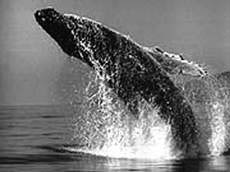
■플로리다 바다황소
바다황소는 우아하고, 평화로운 동물이다. 수초를 먹고 살며, 플로리다 해변가나 운하에 산다. 인도양이나 멕시코만에서 다른 종들을 발견할 수 있다. 행동이 둔하며, 부주의한 모터보트들 때문에 멸종위기에 있다. 대부분의 바다황소 등에는 모터보트에 의한 흉터가 있다.
■바다 수달
아주 귀여운 모양의 이 동물은 모피 때문에 한 때 멸종위기에 처했었다. 현재는 보호 속에 미국 서부 해안에서 사로 있으며, 종이 늘어나는 중이다. 아주 좋아하는 음식인 갑각류를 먹으면서 누워서 헤엄치는 모습을 종종 볼수 있다.
Sponges
Though plant-like in appearance, sponges are actually one of the most primitive animals in the sea. They belong to a group called porifera. Most of us are familiar with the dried colorless varieties that populate the kitchens and bathrooms of the world. But in the ocean, live sponges can be found in an infinite variety of colors and shapes. Most of them are relatively small, but some varieties can grow to over 6 feet in diameter. Sponges differ from all other marine invertebrates in that they have no true tissues or organs. Their structure is composed of simple aggregations of cells. The name porifera means pore bearer. The tissue of sponges encloses a vast network of chambers and canals that connect to the open pores on their surface. Sponges feed by drawing a current of water in through their pores, filtering out the nutrients, and then ejecting it out through an opening. Many sponges on the reef resemble some of the corals in shape and color, but upon closer inspection the difference is apparent. They are one of the many life forms unique to the ocean environment.
Corals & Anemones
Although many people mistake corals and anemones as plants, they are actually animals. They are part of an ancient and simple group of animals known as cnidaria*. Jellyfish are also a member of this group. These animals are characterized by a symmetrical body, usually with stinging tentacles, and a central mouth. A coral structure is actually composed of hundreds or thousands of these tiny animals growing together as a colony. These tiny coral polyps** are the builders of the reef. Their tiny calcium shells have accumulated over thousands of years to form the largest living structures in the world. The majority of the cnidaria live attached in colonies, but a few are free swimming like the jellyfish. Most of these animals use special stinging cells called nematocysts*** to catch their prey. A few of them, particularly the jellyfishes, are capable of inflicting extremely painful stings on humans. The anemones are well known for establishing a symbiotic relationship with members of the clownfish family. This is a special living arrangement where both animals work together to benefit each other. The anemone provides protection for the clownfish, and the clownfish in turn provides food for the anemone.
Marine Mammals
Several million years ago, the first animals moved from the sea to colonize the land. Eventually, world-wide changes in climate and geography convinced some of the mammals to move back to the sea. These animals have since evolved to be perfectly adapted to their environment. Most of these animals comprise a group known as the cetaceans, which includes the dolphins and whales. The other main group of marine mammals fall into the pinnipedia* family, which includes the seals and sea lions. Breathing air and then diving, cetaceans can hold their breath for unimaginable lengths of time. They are peaceful animals, and they are quite intelligent. Some of the largest brains in the world of mammals are found in the oceans. These animals have exhibited remarkable abilities to communicate and learn. Their natural lives are spent in close family groups caring for their young and each other. Their songs can be heard echoing for miles beneath the waves. It is shameful to think that mankind hunted most of these magnificent animals to the brink of extinction. But today, under the protection of most of the world’s governments, they are coming back. In marine parks around the world, their ambassadors are helping to save their kind by helping us to better understand them.
Humpback Whale (Megaptera Novaean-gliae)
The humpback whale is a large animal, growing to 60 feet in length. These animals were one hunted to the brink of extinction, but are now making a comeback. They feed on plankton, and are perhaps best known for their enchanting songs which can be heard for hundreds of miles under the sea.
Florida Manatee (Trichechus Manatus)
The manatee is a graceful and peaceful creature. They feed on water plants, and inhabit the waterways and shores of Florida. Other species are found in the Indian ocean and the Gulf of Mexico. They are slow creatures, and are in danger of extinction due to careless boaters. Most manatees have boat motor scars on their backs.
Sea Otter (Enhydra Lutris)
These adorable animals were once hunted to the brink of extinction for their fur. Inhabiting the coastal waters of the western United States, they are now protected and are making a comeback. They are often seen lying on their backs eating their favorite food - crustaceans.







